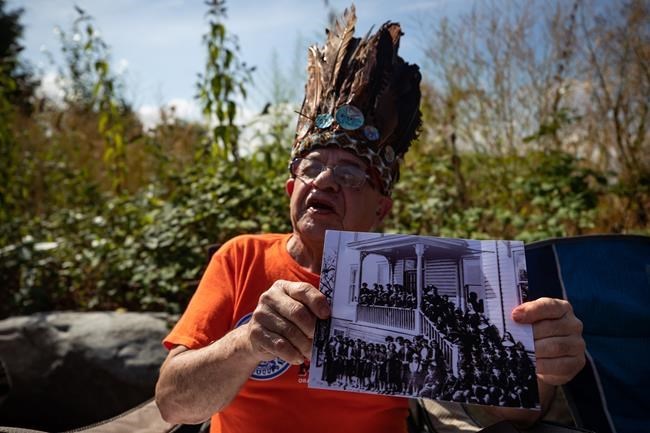VANCOUVER ‚Äî Three British Columbia First Nations have launched an investigation to find answers about children who once attended the former St. Paul's Indian Residential School in North Vancouver but never made it home.¬Ý
The Squamish, Tsleil-Waututh and Musqueam nations announced on Tuesday an Indigenous-led plan to confirm the oral histories told by St. Paul's survivors about an unknown number of children who disappeared.¬Ý
Tsleil-Waututh Nation elected chief Jennifer Thomas attended the news conference wearing an orange shirt printed with a picture of a nun and a group of students outside the former institution. Her father, then a young boy, stands in the front row.
"When we speak of residential schools, we think it's way back in the day, but it's not. It was just one generation ago, my dad," Thomas said in an interview.
"It didn't happen a long time ago, not at all. I'm 53 years old and this just happened yesterday to me ... it's that close to our history here in North Vancouver."
Most elders from Thomas's community attended St. Paul's, though she said some were sent to the Kamloops Indian Residential School, where the Tk‚Äôeml√∫ps te Secwepemc Nation announced in May that the remains of what are believed to be more than 200 children were buried on the school's ground.¬Ý
Speaking after the announcement, Squamish Nation member Willie Nahanee, 79, said he is one of 18 members of his family who attended the St. Paul's institution.¬Ý
Some of his relatives "knelt down all night on their knees and they were only 10, 11 years old, you know, there was that kind of punishment," said Nahanee, who was forced to go to St. Paul's on the day of his sixth birthday in November 1947.¬Ý
Nahanee said his mother tried to keep him and his younger brother out of the school, but officials threatened to jail her if she didn't let them go.
"We left the reserve for five months," he said. "We lived at two, three different houses, but one day, knock on the door, it was a policeman."
More than 2,000 Indigenous children representing six nations attended St. Paul's between 1899 and 1959. Many were then relocated to the school in Kamloops.
Nahanee spent 10 years at St. Paul's before –°¿∂ ”∆µ sent to Kamloops for a year.¬Ý
Squamish Nation representative Khelsilem said during the news conference they know current archives document a number of children who died at St. Paul's, but the records they've received so far from the Canadian government are "piecemeal."
In 1931, an "Indian Agent" reported after an inspection that he suspected children were not –°¿∂ ”∆µ fed properly, according to Indian Residential School History and Dialogue Centre at the University of British Columbia. In 1933, a B.C. official described the school as a "death-trap" and "fire-trap," while overcrowding continued into the 1950s before the building was condemned in 1957, the centre says.¬Ý
Public records show 12 unidentified students died at the school between 1904 and 1913, the three nations said in a joint news release.
Their goal is to find the location of each child and bring them home to rest.
The first steps in their investigation at the site that's now a Catholic high school will be interviewing survivors of St. Paul's and gathering the full records related to the institution before conducting "remote sensing searches in defined areas of interest," which could include ground-penetrating radar, Khelsilem said.
"We also know from some of the accounts that have been shared by some of our survivors that there is a high potential for certain areas to look at."
There have been "bureaucratic" challenges in accessing all relevant information and archives from various branches government and the church, Khelsilem said.
The Roman Catholic Archdiocese of Vancouver owns the St. Paul's site and supports the nations in their investigation, said representative James Borkowski.
Archbishop J. Michael Miller has pledged full co-operation in ensuring that all documents related to residential schools are made available, he said.
The federal government announced Tuesday the addition of $321 million for programs aimed at Indigenous communities that are searching burial sites around former residential institutions, to help survivors and those experiencing intergenerational trauma and to commemorate those who died.¬Ý
While Kamloops was the first to announce the remains of missing children were found, several other First Nations in Canada have since said suspected remains or unmarked graves were located around former residential schools in their territories.¬Ý
"Whether or not unmarked graves are found, there is enough documented oral and archival evidence to say that these burials do or did exist," Khelsilem said.
This report by The Canadian Press was first published Aug. 10, 2021.¬Ý
This story was produced with the financial assistance of the Facebook and Canadian Press News Fellowship.
Brenna Owen, The Canadian Press




